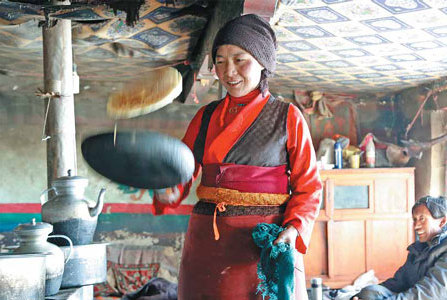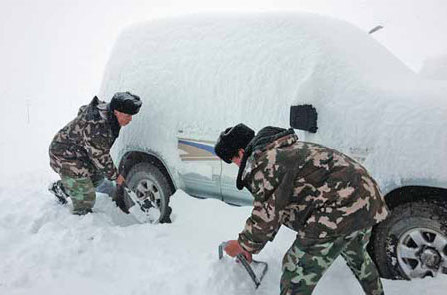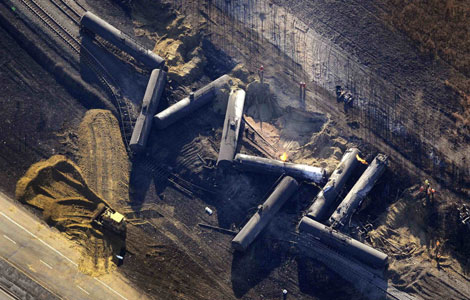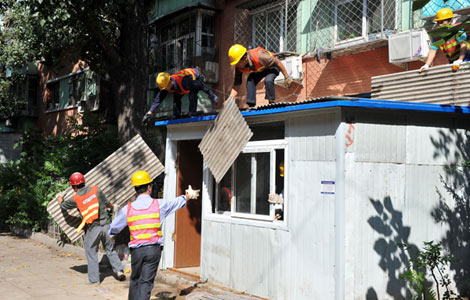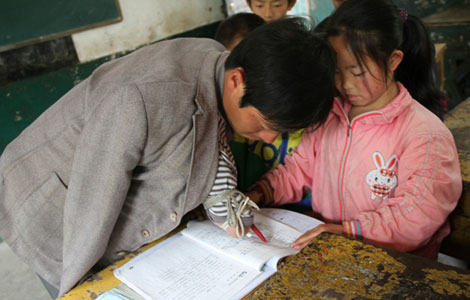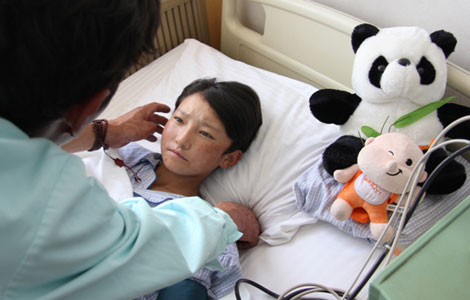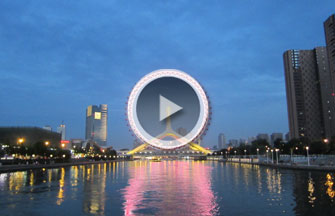Stranded in heavy snow at Qomolangma
Updated: 2013-10-21 07:10
By Wang Huazhong and Da Qiong (China Daily USA)
|
||||||||
Tour operators coming under increasing pressure from rising number of tourists seeking firsthand experience of the mountain, report Wang Huazhong and Da Qiong in Xigaze, Tibet autonomous region
Dazzling sunshine reflected off the snow that covered the deserted northern base camp of Qomolangma, the world's highest mountain. The area is usually packed with tourists enjoying tea in their tents or writing postcards to friends at this time of year. On Friday, however, the only living thing in sight was a black dog wondering around with a rabbit in its mouth.
On Oct 13, the area was struck by a sudden blizzard, which led to the closure of Qomolangma National Park when 154 tourists, 32 of them from overseas, were rescued by local authorities.
On Oct 14, a 60-year-old member of an Australian trekking group died after an avalanche hit their camp one day earlier on the eastern side of the mountain, which is called Mount Everest in the West.
A group of trekkers from New Zealand was also trapped by an avalanche and remained out of contact for three days after issuing a distress call on Oct 15.
The government described the heavy snowfall brought by Cyclone Phailin as "unexpected", and locals said it was the worst since 1994.
However, extreme conditions are not the only pressures faced by local tourism operators and the park's managers.
The revenue from tourism in Dingri county in the Tibet autonomous region, where the peak is situated, surged 15.6 times between 2008 and 2012, with a more-than fivefold increase in visitor numbers during the period.
Trekking, an activity far more dangerous than traditional sightseeing, is gaining in popularity and an increasing number of ill-trained, inexperienced tourists are exploring the area around the mountain, according to insiders. That increase in numbers has led the local authorities to ponder how they can provide a safe, high quality service for tourists and expand the industry.
Emergency evacuation
It took 74 rescue workers and four snowplows an entire afternoon and a night to clear the road which was blocked by snow 50 cm deep, preventing the stranded tourists from leaving the danger zone.
Tsering Lhamo said she wept constantly as she worked to prevent the snow from accumulating atop her tent, which was being used as a guesthouse at the camp.
"We couldn't go anywhere at the time. I was very worried about the guests' safety, because the snow kept falling," said the 43-year-old. "I know from experience that yak tents can be overturned by the strong winds at the camp, but that night three of the six-people tents collapsed under the weight of the snow."
Although Rongbuk Monastery, which is close to base camp, was well stocked with provisions, one tourist, apparently unaware of the situation, called for help via his micro blog, saying, "many people only have enough food for one day".
According to Aysha, deputy head of the border police station on the northern side of the mountain, his office received a call on the afternoon of Oct 14 informing the police that two avalanches had occurred close to the monastery's crowded teahouse.
While Aysha led four officers on the four-hour trek to the camp, the government coordinated operations and sent 40 more rescue workers and 25 policemen as reinforcements.
As the tourists were being escorted down the mountain on the morning of Oct 15, the autonomous region's government was notified that the trekkers from New Zealand had sent out an SOS, saying they were trapped in Choitang village in the Garma Valley at the foot of the eastern side of the mountain, often known to mountaineers as the Kangshung Face.
Snow reported to be a meter deep hindered the rescue attempts and caused temporary telecommunications blackouts.
Dean Higgins, a 60-year-old Australian, died of hypothermia after spending six hours digging with his bare hands to reach his wife and two other companions who had been buried in snow, ice and rock by an avalanche on Oct 13.
Unlike traditional sightseers who travel to base camp in motor vehicles, the two foreign groups, assisted by local guides, cooks and porters, chose to trek to the east side of the mountain.
Fortunately, all the stranded tourists on the northern side of the mountain were evacuated safely and rescue workers discovered the missing group from New Zealand sound and safe on Oct 18.
"Incidents such as this happen very rarely. But we will think about how to better communicate with the local government and improve our emergency action plan," said Paldron, general manager of the Tibet Holyland International Travel Agency, which organized the New Zealanders' trip.
In a review of the incident, the government of Dingri admitted that it "did not handle the information provided by weather forecasts accurately and also failed to prevent tourists from heading for the destination in time". The government also said the communications facilities in and around the camp were not up to standard.
'Just within control'
The deciding factor in the success or failure of a rescue operation is money. In addition to natural disasters, tour operators are coming under increasing pressure from the enormous number of tourists seeking first-hand experience of the mountain and their eagerness to "explore" the area.
"It's not just foreign tourists, but also a lot of domestic tourists choose to trek, for a variety of reasons," said Jigmed Namgyal, deputy general manager of the Tibet Longda International Travel Agency, which was hired by the Australian trekkers to organize their visit.
When sharing his trekking experiences, one Chinese blogger wrote, "Going to Milan is happiness. Crossing the Garma Valley with leeches sucking your blood is also happiness."
According to Jigmed Namgyal, whose company provided services for 300 foreigners in 2012 alone, the local government does not oppose the development of this high-value-added activity in the park, which was officially opened in October 2012. Within its 78,000 sq km are five peaks that stand 8,000 meters above sea level and 10 others that are higher than 7,000 meters.
The number of visitors to the area rose from 13,374 in 2008 to 73,000 in 2012, according to figures provided by the Dingri county tourism bureau. In 2008, the zone received 2,698 foreign tourists, but by 2010 a record 18,700 foreigners visited the area, the highest number for five years.
More tourists, revenue
"We get more tourists and more revenue, but also more challenges and problems as well," said Xiong Jianbiao, director of the "110" help line at Dingri's public security bureau.
In the first 10 months of this year, the county's police station responded to 151 calls for help from tourists, 127 of them from tourists on Qomolangma.
In most cases, the tourists had experienced altitude sickness or become lost because of their unfamiliarity with the roads, according to Xiong.
"We have to respond, and the situation is just within our control. But it has grave implications because of the limited number of police officers available."
Tashi Dawa, head of the border police station at Qomolangma, said his officers receive four or five calls for assistance during the peak tourist seasons.
As an example, he spoke about a man from Shandong province who last year used the Internet to study the routes other trekkers had used. The knowledge he accrued allowed him to evade the police checkpoints as he attempted to ascend further up the mountain. A number of officers from Tashi Dawa's station had to be dispatched to search for the man when he lost his way.
Climbing to areas higher than 5,500 m is classed as mountaineering, not trekking, and those who wish to do so must submit an application to the local mountaineering association, which checks their eligibility. Climbers must also pay a hefty registration fee, which can be as much as 200,000 yuan ($33,000).
"Searching for missing people is not our main responsibility, but we have to do our best to save people's lives," said Tashi Dawa.
Galsang Drolma, an assistant researcher at the China Tibetology Research Center, said decision-makers in the autonomous region should consider the negative side effects and constraints when they formulate policies to develop the area into a world-tourism destination. She said the policies should examine the "ecological and infrastructure capacities and the adaptability of the locals to the development".
She also suggested establishing a system to monitor tourism projects, emphasizing that it should evaluate service standards and the real-time risks to provide tourists with a safe service and accurate information.
Dingri county is currently without electricity. The outage, which has been ongoing for two months, is the second to have happened this year as a result of insufficient capacity at the local hydroelectric station and poor performance during the "low-flow" period. The best hotels in town have restricted the use of generators to three hours a day, from 9 pm to 12 pm, while government officials only power up their generator when they want to send e-mails.
He Xianjiang, a local official, said he goes to bed at about 8 pm most evenings, once work is over for the day "because civil servants shouldn't go to teahouses too often, and it's too cold to leave your hands outside the quilt when you're reading."
Electricity is even more of a luxury in Zhaxizom village, about 40 km from Qomolangma. The residents are determined to develop the tourism industry, which has generated 5 million yuan so far and raised the annual per capita income of the 7,004 villagers to 40,000 yuan.
Many villagers earn a living by running guesthouses, working as yak porters and guides or as rubbish collectors at the camp.
"My younger brother is a tour guide. He is learning English in Lhasa," said guesthouse owner Galsang Tendron.
"Irrigation is a big problem for agriculture on the plateau and there isn't much business because the locals consume few commodities, products or foodstuffs. I can't imagine what life here would be like without tourism," said the 27-year-old.
A draft plan for the development of tourism in Dingri is due to be submitted for appraisal by local legislators. It calls for the adoption of an "eco-tourism" model and the establishment of a management committee to improve coordination and management. It also suggests establishing a warning and emergency relief system to ensure the safety of visitors.
Despite the numerous risks, tourists still seem determined to visit one of the most awe-inspiring, but dangerous, places in the world. As Pat Sole, one of the stranded New Zealanders, told China Daily: "I suggest you follow your dreams, but be well prepared, physically and mentally because anything can happen... Many people have been less fortunate than us."
Contact the writers at wanghuazhong@chinadaily.com.cn and daqiong@chinadaily.com.cn
|
A Buddhist nun prepares pancakes for people at Rongbuk Monastery, which is close to the base camp of Mount Qomolangma in the Tibet autonomous region. Da Qiong / China Daily |
|
Police officers from Qomolangma police station work to dig out a car at the base camp, where tourists were stranded by snow. Provided to China Daily |
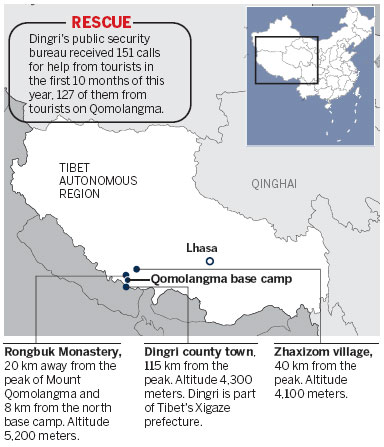
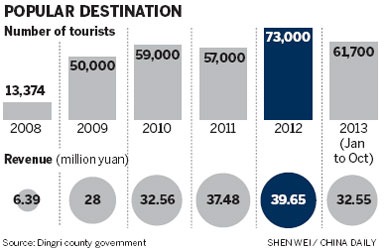
(China Daily USA 10/21/2013 page7)
Most Viewed
Editor's Picks

|
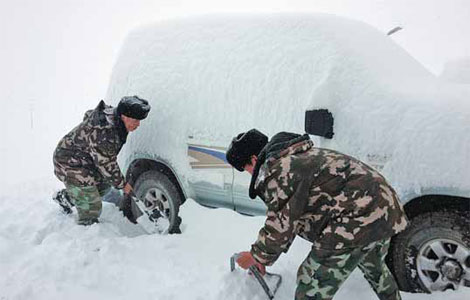
|

|

|
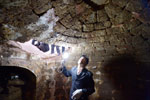
|

|
Today's Top News
China has to brace for next dollar drama
Life of Pi artwork on display
Canada welcomes China to invest
No criminal charges in Asiana crash death: DA
US deal key to nabbing fugitives
Trending news across China
Seattle high-tech summit talks 'green'
JPMorgan reaches $13b deal
US Weekly

|

|
